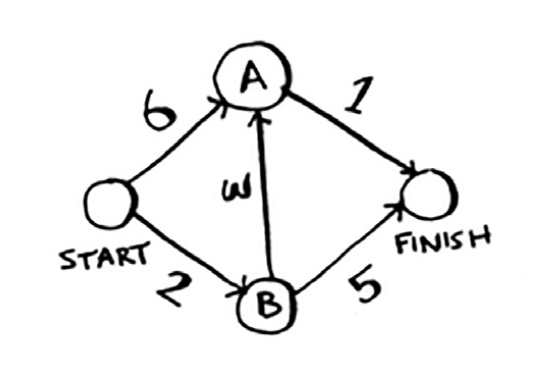Thus far we have looked at the Breadth First algorithm to solve graphing problems where we had to find the shortest path. However, the shortest path doesn’t mean the fastests.
Dijkstra’s algorithm conists of 4 steps:
- Find the cheapest node (smalles weight)
- Update the neighbors node’s costs
- Repeat until done for every node
- Calculate the final path.

Step 1.
| Node | Weight |
|---|---|
| A | 6 |
| B | 2 |
| Finish | ♾ |
Step 2. (we picked the cheapest node B)
| Node | Weight |
|---|---|
| A | 5 (2 + 3) |
| B | 2 |
| Finish | 7 (2 + 5) |
Step 3. (repeat with next cheapest node A)
| Node | Weight |
|---|---|
| A | 5 (updated) |
| B | 2 |
| Finish | 7 (updated) |
| Node | Weight |
|---|---|
| A | 5 |
| B | 2 |
| Finish | 6 (2 + 3 + 1) |
Using this algorithm we assign a weight to each segment and find the path with the smallest total weight.
Each edge in the graph has a number associated with it. That number is called a weight and makes the graph a weighted graph. Thus, the Breadth First search algorithm is ideal for unweighted graphs while Dijkstra’s algorithm is ideal for weighted graphs.
Graphs can have cycles that just add extra weight to the path. This happens with graphs that are undirected. Thus, Dijkstra’s algorithm only works with “Directed acyclic graphs” DAG.
With each iteration we also update the parents of each node to know how we got the cheapest path. Sometimes graphs have a negative weight. In those cases, the algorithm doens’t work. However, Bellman-Ford’s algorithm works with negative weights.
